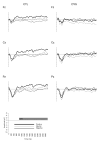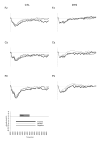Anticipation of affect in dysthymia: behavioral and neurophysiological indicators
- PMID: 18063468
- PMCID: PMC2709790
- DOI: 10.1016/j.biopsycho.2007.10.007
Anticipation of affect in dysthymia: behavioral and neurophysiological indicators
Abstract
Anticipation for future affective events and prediction uncertainty were examined in healthy controls and individuals with dysthymia (DYS) using behavioral responses and the contingent negative variation (CNV) and post-imperative negative variation (PINV) event-related potential (ERP) components. Warning stimuli forecasted the valence of subsequently presented adjectives ("+", positive; "=", neutral; "-", negative), and participants indicated whether each adjective would describe them over the next two weeks. Controls expected fewer negative, and individuals with DYS expected fewer positive, adjectives to apply to them. CNV amplitudes were enhanced in controls prior to positive versus other adjectives. Response times and PINV amplitudes were greater following neutral compared to other adjectives, and PINV was larger overall in dysthymics compared to controls. In sum, healthy controls and individuals with DYS exhibit different behavioral and neurophysiological biases in anticipation for future affective events. These results are discussed in the context of cognitive theories of depression.
Figures




Similar articles
-
Contingent negative variation (CNV) and determinants of the post-imperative negative variation (PINV) in schizophrenic patients and healthy controls.Schizophr Res. 1996 Aug 23;21(2):97-110. doi: 10.1016/0920-9964(96)00028-x. Schizophr Res. 1996. PMID: 8873777
-
Topography of CNV and PINV in schizotypal personality.Psychophysiology. 1998 May;35(3):272-82. doi: 10.1017/s0048577298961212. Psychophysiology. 1998. PMID: 9564747 Clinical Trial.
-
Preparatory brain potentials in major depressive disorder.Prog Neuropsychopharmacol Biol Psychiatry. 1991;15(2):257-62. doi: 10.1016/0278-5846(91)90089-j. Prog Neuropsychopharmacol Biol Psychiatry. 1991. PMID: 1871326
-
Increased performance uncertainty in children with ADHD? Elevated post-imperative negative variation (PINV) over the ventrolateral prefrontal cortex.Behav Brain Funct. 2011 Aug 25;7:38. doi: 10.1186/1744-9081-7-38. Behav Brain Funct. 2011. PMID: 21867487 Free PMC article.
-
Slow EEG potentials (contingent negative variation and post-imperative negative variation) in schizophrenia: their association to the present state and to Parkinsonian medication effects.Clin Neurophysiol. 1999 Jul;110(7):1175-92. doi: 10.1016/s1388-2457(99)00023-1. Clin Neurophysiol. 1999. PMID: 10423184
Cited by
-
Time-dependent post-imperative negative variation indicates adaptation and problem solving in migraine patients.J Neural Transm (Vienna). 2012 Oct;119(10):1213-21. doi: 10.1007/s00702-012-0843-6. Epub 2012 Jun 12. J Neural Transm (Vienna). 2012. PMID: 22688673
-
Getting ready for an emotion: specific premotor brain activities for self-administered emotional pictures.Front Behav Neurosci. 2014 May 28;8:197. doi: 10.3389/fnbeh.2014.00197. eCollection 2014. Front Behav Neurosci. 2014. PMID: 24904344 Free PMC article.
-
Sensorimotor brain dynamics reflect architectural affordances.Proc Natl Acad Sci U S A. 2019 Jul 16;116(29):14769-14778. doi: 10.1073/pnas.1900648116. Epub 2019 Jun 12. Proc Natl Acad Sci U S A. 2019. PMID: 31189596 Free PMC article.
-
Subdividing Stress Groups into Eustress and Distress Groups Using Laterality Index Calculated from Brain Hemodynamic Response.Biosensors (Basel). 2022 Jan 9;12(1):33. doi: 10.3390/bios12010033. Biosensors (Basel). 2022. PMID: 35049661 Free PMC article.
-
Modulation of early and late event-related potentials by emotion.Front Integr Neurosci. 2012 Nov 8;6:102. doi: 10.3389/fnint.2012.00102. eCollection 2012. Front Integr Neurosci. 2012. PMID: 23162444 Free PMC article.
References
-
- Abramson LY, Metalsky GI, Alloy LB. Hopelessness depression: A theory-based subtype of depression. Psychological Review. 1989;96:358–372.
-
- Abramson LY, Seligman ME, Teasdale JD. Learned helplessness in humans: Critique and reformulation. Journal of Abnormal Psychology. 1978;87:49–74. - PubMed
-
- Andersen SM, Spielman LA, Bargh JA. Future-event schemas and certainty about the future: Automaticity in depressives' future-event predictions. Journal of Personality and Social Psychology. 1992;63:711–723. - PubMed
-
- Ashton H, Golding JF, Marsh VR, Thompson JW, Hassanyeh F, Tyrer SP. Cortical evoked potentials and clinical rating scales as measures of depressive illness. Psychological Medicine. 1988;18:305–317. - PubMed
-
- Beck AT. Depression. Harper and Row; New York: 1967.
Publication types
MeSH terms
Grants and funding
LinkOut - more resources
Full Text Sources

